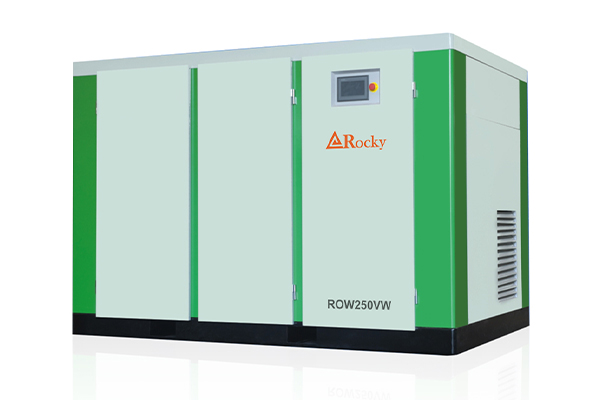
The hydraulic system of the diaphragm compressor is composed of a compensation oil pump, an oil inlet and outlet check valve, an automatic pressure regulating valve, etc. When the compensation oil pump is in operation, the plunger overcomes the spring force along the pump under the effect of the bearing of the eccentric device on the crankshaft. The reciprocating motion in the plunger cylinder makes the working volume at the top of the plunger periodically increase and decrease. During the increase process, the working volume pressure drops, and the working oil pressure inside the fuel tank is greater than the sum of the spring force in the intake valve and the working volume pressure, the intake valve is opened, and some working oil enters the pump cavity; During the process, the working volume pressure rises, and when the working volume pressure is higher than the sum of the spring force of the oil discharge valve and the liquid pressure of the hydraulic chamber, the oil discharge valve is opened, and the working oil enters the hydraulic chamber. Under the effect of the active pressure regulating valve, the pressure of the oil inlet and outlet in the oil cylinder is automatically adjusted, because the hydraulic oil in the hydraulic cylinder will leak through the piston ring. Compensate to the hydraulic cylinder for the amount of oil leaking more than the piston ring to compensate for the amount of hydraulic oil that leaks, and the remaining oil is discharged back to the oil tank through the active pressure regulating valve.
Diaphragm compressor failure phenomenon and reason analysis
fault one
The manual unloading handle of the pressure regulating valve often leaks oil; the direct rod in the pressure regulating valve and the oil cylinder is often broken and oil is injected. After analysis, because the unit must be started with light load every time before starting, the manual unloading of the pressure regulating valve must be The handle is changed to the unloading position, and the unloading handle and the pressure regulating valve are sealed by an O-ring. Changing 3 to 4 times will cause the seal to fail and leak oil; the characteristics of the diaphragm compressor determine that the oil inside the working cylinder is in the system. It is pulsating. In each working cycle, the working oil in the oil cylinder forms a pulsating impact on the pressure regulating valve. Originally, the pressure regulating valve is directly connected to the working cylinder oil cylinder through the middle rod. Because the unit oscillates greatly, it is easy to form a long The middle direct rod is fatigued and broken due to the local stress concentration at the two ends of the thread connection. Remove it and plug it directly, as shown in Figure 2 and Figure 3, to reduce the leakage point. At the same time, add a ball valve in front of the active pressure regulating valve, and open the ball valve before starting to ensure that the unit starts with light load. After the unit starts normally, the ball valve is closed. Closed, the oil pressure inside the working cylinder is actively controlled by the active pressure regulating valve, and the two units have been tested to reduce six leakage points, and the effect is excellent
fault two
Some working cylinders of each unit do not work, the pressure and flow cannot meet the demand, and the service life of the diaphragm is very short. After analysis, when the unit was put into operation, the inlet pipe was not completely purged, resulting in some debris such as welding slag stuck. On the intake and exhaust valve, the air valve loses its effect, causing the cylinder to not work. The reason is that the inlet filter is not drawn before the unit is put into operation, and then the intake filter is added before the inlet pipe, and the diaphragm of each operating cylinder The number is increased from the originally described two to three, which improves the safety of the nitrogen system of the entire unit and reduces the maintenance labor intensity of workers.